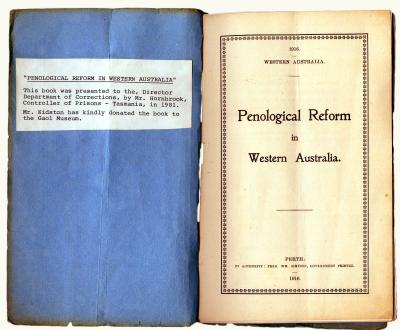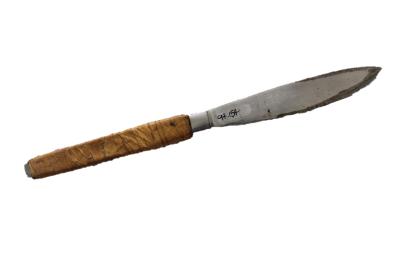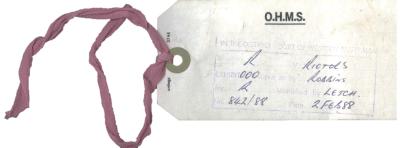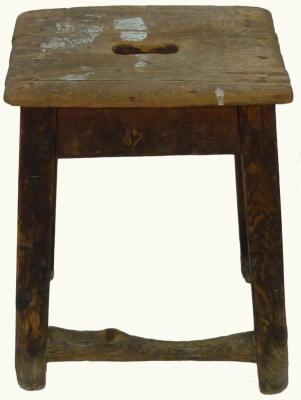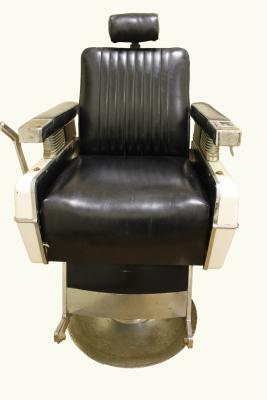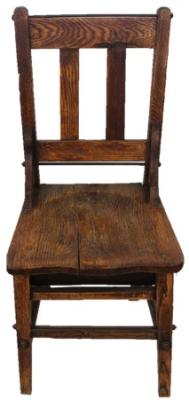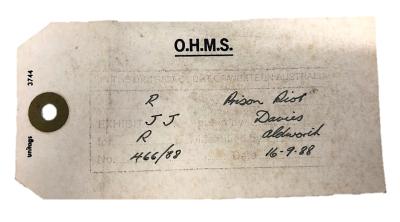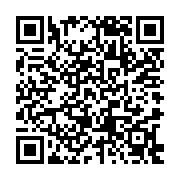LANDSCAPE PAINTING
Large, landscape, acrylic painting, depicting prospect of river and trees. A blue river runs through the painting in perspective from bottom right to midground centre between banks. The left foreground consists of the left embankment featuring trunks of two white salmon gum trees amidst lush green vegetation. The right side midground consists of right embankment featuring trunks of two salmon gums amidst lush green vegetation. The upper part consists of dense forest of trees acting as a backdrop. The painting is unsigned. This painting covers another layer of paints with a relief of dots and lines visible in parts. The back of the board is dirty with grey and black smudges of paint and footprint marks. A section of masking tape has been adhered to the top right-hand corner with the inscription, 'McARTHUR J' in black paint. The painting is framed in a modern, dark wood frame.
Found on the floor in the Reception store, unframed, in 2012. Attributed to artist Jackie McArthur.
Details
Details
In 1978 Steve Culley began teaching art classes at Fremantle Prison, soon accompanied by David Wroth and Lindsey Pow. The popularity of their art program can be gauged by the number of prisoners who enrolled; more than 2,000 students within the first five years. As the popularity of the art classes grew, they were moved into a larger space in the Assessment Centre. The Assessment Centre was considered secure enough that prisoners could come and go freely. When the Prison took back this space two years later, the art classes were moved into the Main Cell Block, behind the Catholic Chapel.
Prison art provides a valuable and unique insight into the prison experience, reminding us that sites of incarceration are first and foremost about people, not buildings. Created by the prisoners themselves, prison art allows those who have been silenced by the system a voice and way to express themselves. In the context of Fremantle Prison the art collection also provides an insightful and much more personal perspective on the experience of incarceration.
Aboriginal prisoners were initially the only students allowed to participate in the art classes at Fremantle Prison. Steve Culley is recorded as saying that at the beginning he was teaching about 15 Wongai artists from the Warburton/Mt Margaret area. At the Mt Margaret Mission, where a lot of these prisoners had previously been confined, the principals applied strict discipline. The result was that these Aboriginal artists, although they’d been born to a traditional tribal life, had not gone through the law. The Mission had succeeded in isolating them from their traditional ways, forcing them into European education of reading and writing. In the art classes at Fremantle Prison, Culley encouraged these men to embrace their traditions. Their success meant that Culley was soon overrun with students, so he began to make certain students into student teachers. One of these was Jackie McArthur, a Wongai man who ran a Namatjira landscape school.
Bureaucracy, in one form or another, was mainly responsible for artworks being left behind when Fremantle Prison closed in 1991, and prisoners were moved to Casuarina. If a prisoner created or acquired something during their incarceration, which they did not have when they were first admitted to prison, they had to apply for that article to be added to their record, so that such items could be taken with them when they left or were transferred. It is likely that a number of the artworks now in the Fremantle Prison Collection were never claimed by prisoners in this way, and as a result where left behind when the Prison closed.







